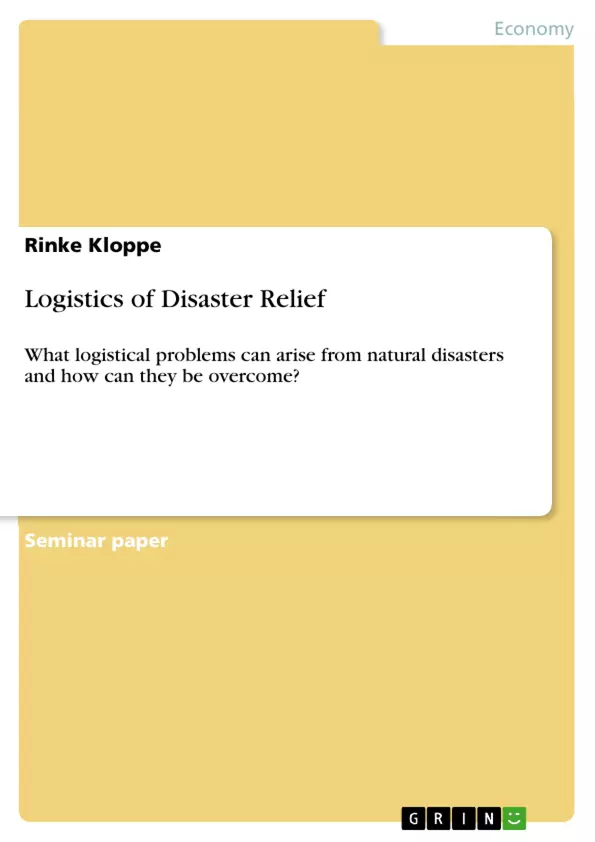In regard to the text book “International Logistics” I have chosen the chapter “Logistics and famine relief” asking myself the question:
“What logistical problems can arise from natural disasters and how can they be overcome?”
Based on the Hurricane Katrina in August 2005, which has destroyed an entire landscape killing thousands of people and making even more homeless, I have developed my paper by introducing the different modes of transport that exist to support the logistics network in terms of disaster relief: plane, boat, rail, road, helicopters, rescue boats (hovercrafts, canoes and small boats).
Pointing out the disadvantages and advantages of each mode I came to the conclusion that each of them serves special needs in certain situations so that all of them can be regarded as equal in their function.
Concerning financial factors, however, the appropriability differs: shipment is more expensive than rail transport, for example.
I also found out in which way the modes of transport can reach best the affected areas and how the distribution is organized.
Based on this theoretical framework, I have switched to the question how the needs of people change after a natural disaster such as Katrina in the short and the long term. To put it in a nutshell, people long for basic provisions such as food and water in the short term but start to demand for luxury goods such as electricity again in the long term.
Last but not least I have focused in my analysis on special issues that are affected (interrupted, destroyed, etc.) by natural disasters: re-routing, supply chain and warehousing.
Inhaltsverzeichnis (Table of Contents)
- Introduction
- Literature Review
- Theory
- Different Modes of Transport
- Air Transport
- Air Planes
- Helicopters
- Boats
- Railways
- Roads
- Rescue Boats: hovercrafts, canoes, small boats
- Air Transport
- Reasons why Relief Logistics are Delayed
- Different Modes of Transport
- Analysis
- How the needs of people change
- Re-routing
- Supply chain
- Warehousing
- Time Relapse
- Adaptation
- Results
- Conclusion
- References
Zielsetzung und Themenschwerpunkte (Objectives and Key Themes)
This paper explores the logistical challenges posed by natural disasters, using Hurricane Katrina as a case study. It aims to understand the logistical problems that arise in the aftermath of such events and how these challenges can be overcome. The paper analyzes different modes of transport used for disaster relief, examines how people's needs change in the short and long term, and investigates the impact of disasters on re-routing, supply chains, and warehousing.
- The role of logistics in disaster relief
- The challenges of using different modes of transport in disaster situations
- The evolving needs of disaster victims
- The impact of disasters on supply chains and warehousing
- The importance of adaptation and re-routing in disaster logistics
Zusammenfassung der Kapitel (Chapter Summaries)
The paper begins with an introduction that highlights the importance of logistics in both everyday life and emergency situations, and outlines the devastating impact of Hurricane Katrina on New Orleans and its logistics providers. It then explores the various sources of information used for the research, including academic articles, government reports, and industry websites.
The chapter on Theory delves into the different modes of transportation used for disaster relief, examining the advantages and disadvantages of each, including airplanes, helicopters, boats, railways, roads, and rescue boats. It also discusses the factors that contribute to delays in disaster relief logistics.
The chapter on Analysis focuses on how the needs of people change after a disaster, looking at the short-term and long-term demands for basic provisions and luxury goods. It also examines the impact of disasters on re-routing, supply chains, and warehousing.
Schlüsselwörter (Keywords)
The main keywords and focus topics of this paper include disaster relief, logistics, transportation, Hurricane Katrina, supply chain, warehousing, re-routing, adaptation, and the changing needs of disaster victims.
- Quote paper
- Rinke Kloppe (Author), 2007, Logistics of Disaster Relief, Munich, GRIN Verlag, https://www.grin.com/document/145246



